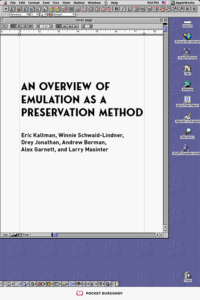Alexandria, VA, July 2025—The Council on Library and Information Resources (CLIR) announces the publication of An Overview of Emulation as a Preservation Method, by Eric Kaltman, Winnie Schwaid-Lindner, Drey Jonathan, Andrew Borman, Alex Garnett, and Larry Masinter. This report is the latest addition to CLIR’s Pocket Burgundy series.

Emulation–the use of modern computer systems to run historical software–is a growing practice within libraries, archives, museums, and galleries that is essential to conserving and providing access to the digital past. Emulation makes it possible to interact with historical data and digital artifacts in ways that are more consistent with creators’ intentions, helping contemporary users better understand digital works in their original context. Increasingly, academic and cultural organizations face challenging decisions about whether emulation is the right strategy for their needs as they curate and preserve their collections. An Overview of Emulation as a Preservation Method introduces fundamental concepts related to emulation in practice and explains key considerations to inform sound decision making about when to employ it. The report also includes a review of academic literature related to emulation and suggests new avenues for potential future exploration. Together, the conceptual overview, example use cases, and literature review provide readers new to emulation with an orientation to the current state of practice as well as a thorough understanding of the important role of emulation in the larger field of digital preservation.
The six authors of the report are members of the Software Preservation Network (SPN) Technological Infrastructure Working Group. Over several years, this group has been documenting and sharing insights about emulation workflows actively employed in academic and cultural settings. Their work aims to establish best practices and inform scalable infrastructure solutions that can be broadly shared so that legacy software can become more accessible and maintainable in the future.
“A driving motivation of this Pocket Burgundy is to make emulation more approachable and accessible to people across GLAM [galleries, libraries, archives, and museums], especially those without deep technical backgrounds,” notes author Winnie Schwaid-Lindner. “We were inspired by discussions of emulation over the last several years, where questions relating to its viability, use, and practical limitations frequently come up. We wanted to address these questions.”
Schwaid-Lindner and colleagues were struck by the “robustness of the conversation within the literature review, [which was] helpful in providing a solid body of work and references through which interested readers can go deeper.” She continues, “This report is intended to support a base-level of conversation, on which we hope others will build (or challenge) to help push the field further.”
An Overview of Emulation as a Preservation Method is part of the CLIR Pocket Burgundy series, which features concise publications on topics within the information and cultural heritage sectors. To access this free publication and others from CLIR, visit clir.org/pubs/reports.
About the Council on Library and Information Resources:
The Council on Library and Information Resources (CLIR) is an independent, nonprofit organization that forges strategies to enhance research, teaching, and learning environments in collaboration with libraries, cultural institutions, and communities of higher learning.
For media inquiries, please contact:
Lizzi Albert
Community Relations Manager
lalbert@clir.org
